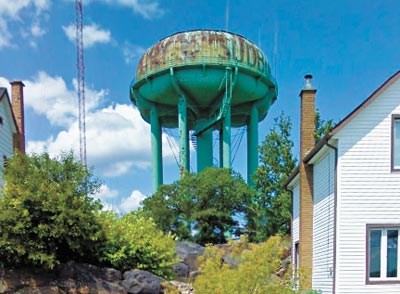The match hasn’t set fire to the fuse yet, but it’s lit at this point.
At its Feb. 16 meeting, the city’s planning committee approved a recommendation that will, potentially, lead to the destruction of the Ash Street water tower (also called the Pine Street water tower).
It’s likely the final decision will be made at the Feb. 24 council meeting, Ward 6 Councillor and chair of the planning committee, André Rivest, said.
If the fate of the water tower isn’t brought up at council, the planning committee’s decision will stand, and the tower will be destroyed.
Revamping the building was an option the city considered, but a lack of funding shut down that possibility, said Ward 3 Coun. Claude Berthiaume.
“It’s pretty difficult when (it comes to) budget time.”

We looked at it and did all we could to try and preserve the water tower. (Now) we have to make sure we don’t just tear it down and have no memories.
Coun. Evelyn Dutrisac,
Ward 4
“The province gave us the authority to protect heritage buildings. The problem is there was never any funding that came with it,” Berthiaume said.
As far as holding onto the building for cultural value, it was ruled out by the planning committee.
“The Municipal Heritage Committee had a look at it and reviewed the building and found it to be of low to moderate cultural value,” Berthiaume said.
The water tower falls in Ward 4, the ward of Coun. Evelyn Dutrisac. She is also on the Municipal Heritage Committee.
The committee is a city-affiliated group responsible for determining whether buildings should be kept as heritage buildings through provincially-set guidelines.
The Municipal Heritage Committee examined the cultural heritage value of the site, using nine criteria set out in the Ontario Heritage Act. This evaluation involved several site visits, historical and archival research, consultation with engineering staff and a survey of seven other Ontario municipalities with similar elevated water tanks.
At a meeting in November 2009, the committee recommended the property be included in the city’s register of heritage properties.
“We looked at it and did all we could to try and preserve the water tower,” Dutrisac said. “(Now) we have to make sure we don’t just tear it down and have no memories.”
Back in July 2008, city council postponed the planned demolition of the water tower to provide the Municipal Heritage Committee with time to evaluate its “cultural heritage value” or “interest of the structure,” city reports state.
The tower is located on the north side of Pine Street, just west of Beatty Avenue. The water tower is roughly 40 metres tall and can hold about 2.3 million litres of water. It was constructed in 1946 and became operational in 1948.
The tower served as part of the city’s water supply system for 50 years. In 1998, the Ellis Reservoir was opened, and the tower was decommissioned and disconnected from the surrounding water supply system.
From a structural standpoint, Rivest said the building isn’t beyond repair.
“I have a hard time believing the structure is finished. There’s a lot of life left in there.”
If the building is destroyed, the city will look into erecting a plaque, among other options, to serve as a link to the past for residents.
Criteria for judging heritage buildings
The Ontario Heritage Act states “a property may be designated under section 29 of the Act if it meets one or more of the following criteria for determining whether it is of cultural heritage value or interest:”
The property has design value or physical value because it:
- is a rare, unique, representation or early example of a style, type, expression, material or construction method;
- displays a high degree of craftsmanship or artistic merit; or
- demonstrates a high degree of technical or scientific achievement.
The property has historical value or associative value because it:
- has direct associations with a theme, event, belief, person, activity, organization or institution that is significant to a community;
- yields, or has the potential to yield, information that contributes to an understanding of a community or culture; or
- demonstrates or reflects the work or ideas of an architect, artist, builder, designer or theorist who is significant to a community.
The property has contextual value because it:
- is important in defining, maintaining or supporting the character of the area;
- is physically, functionally, visually or historically linked to its surroundings; or
- is a landmark.
